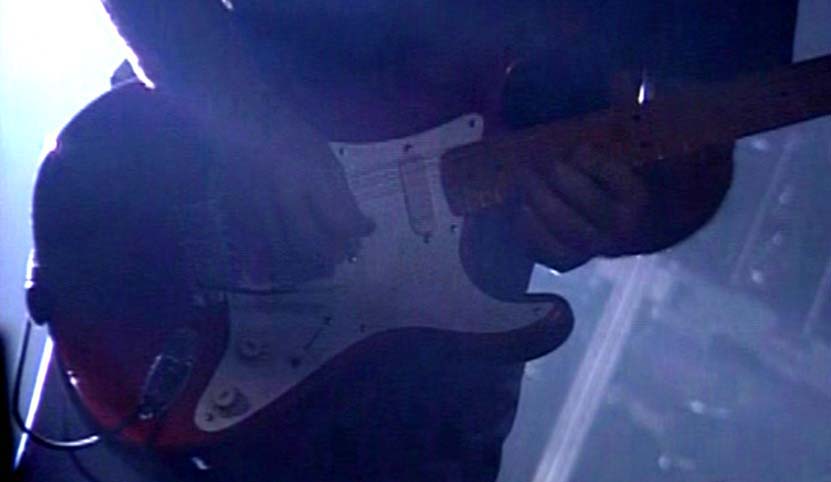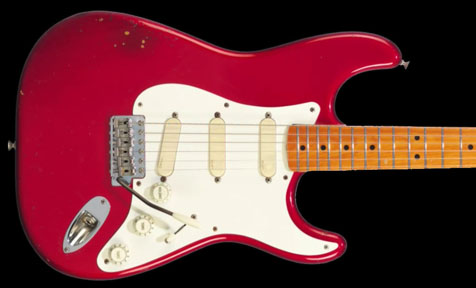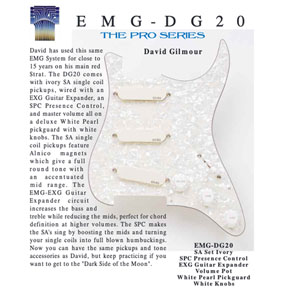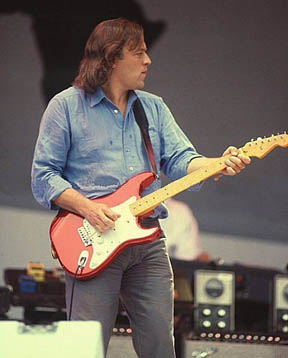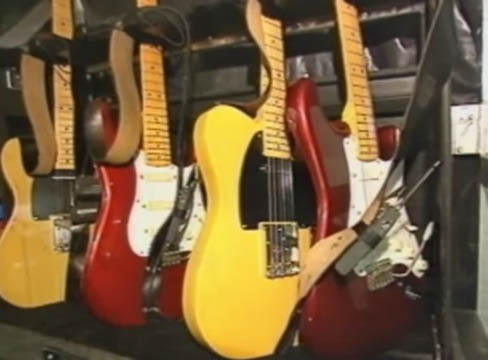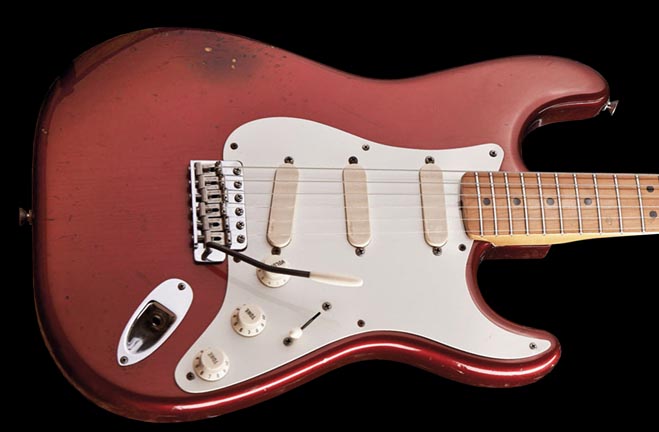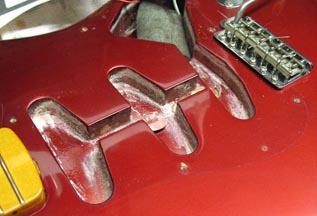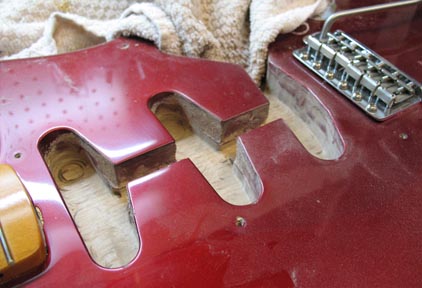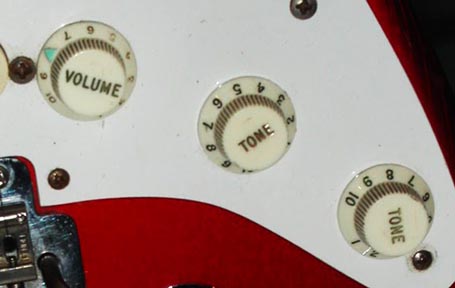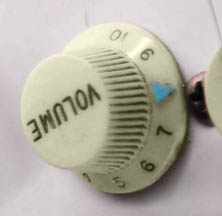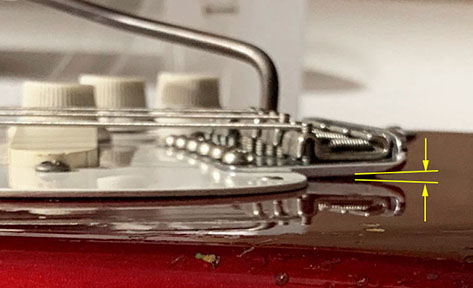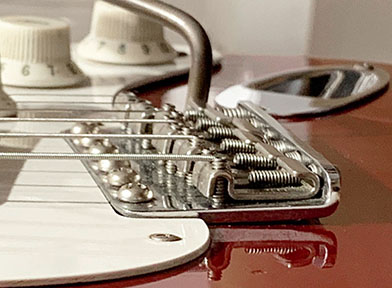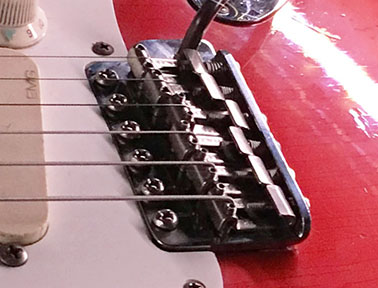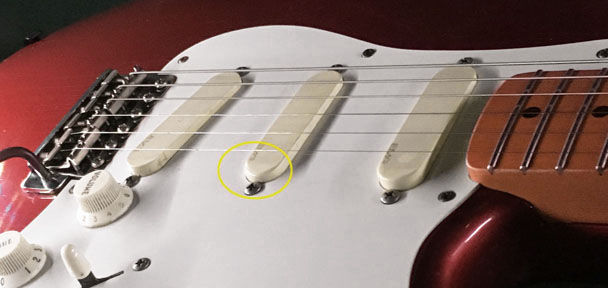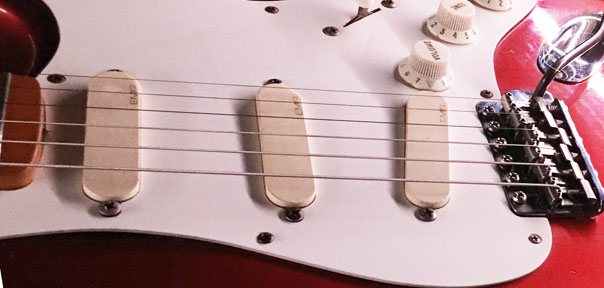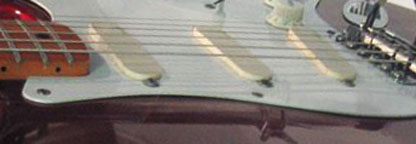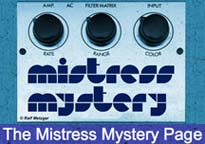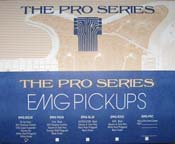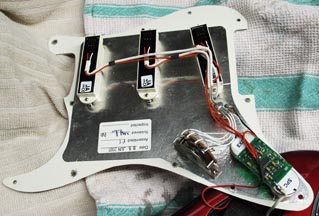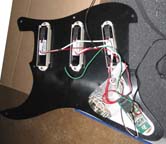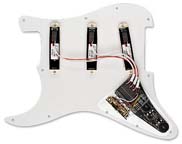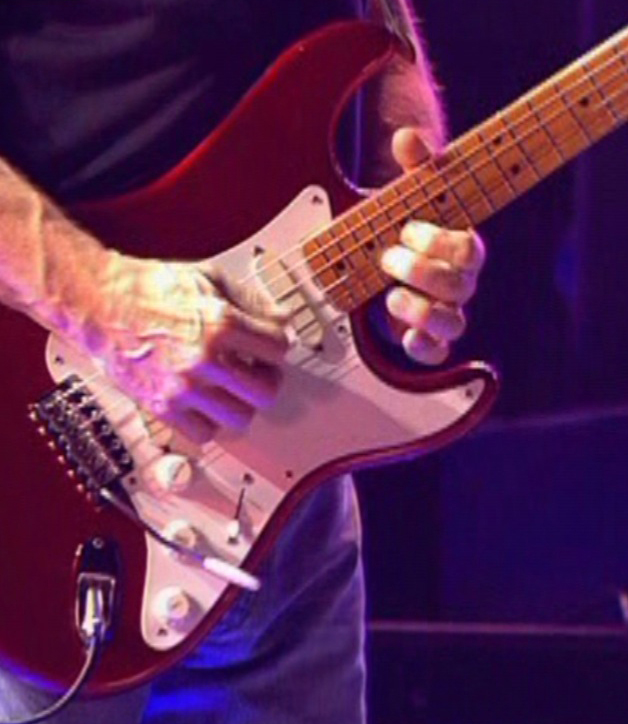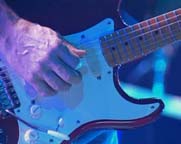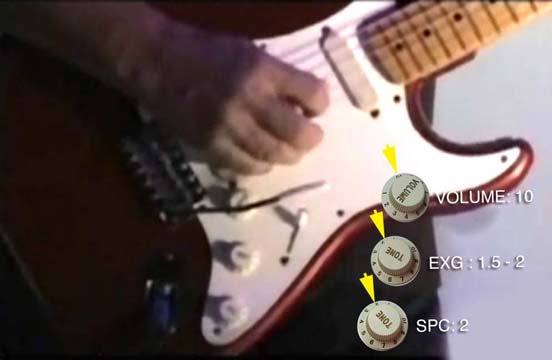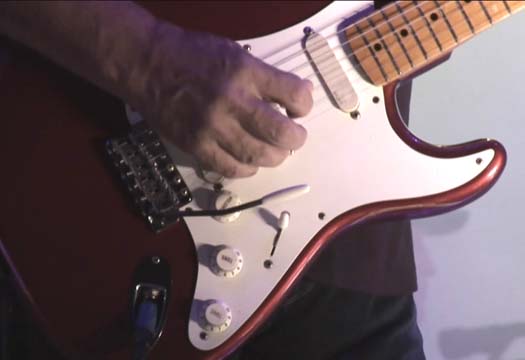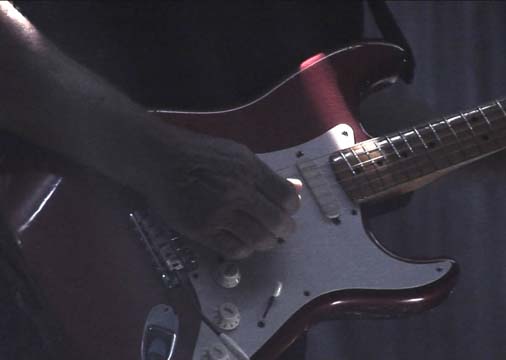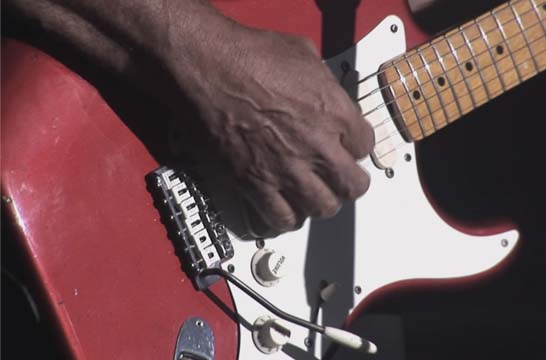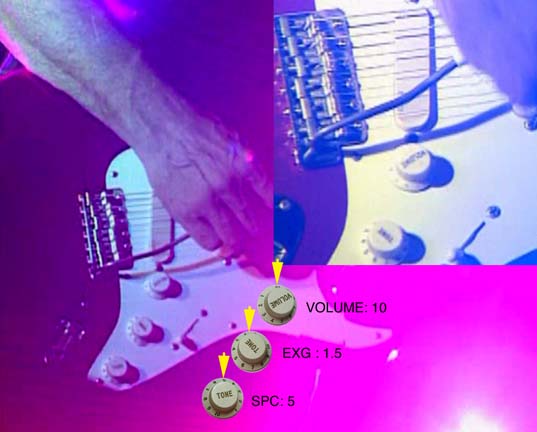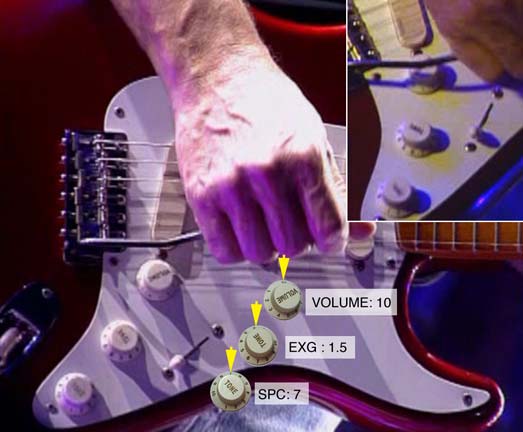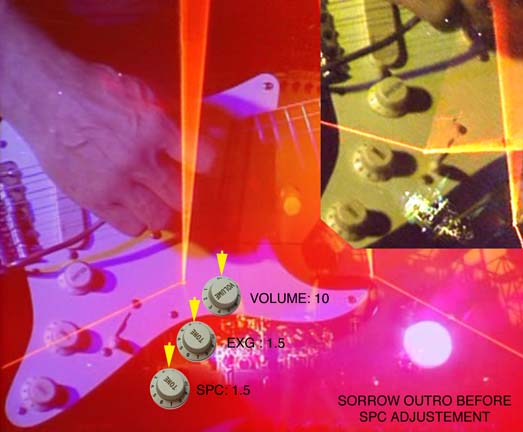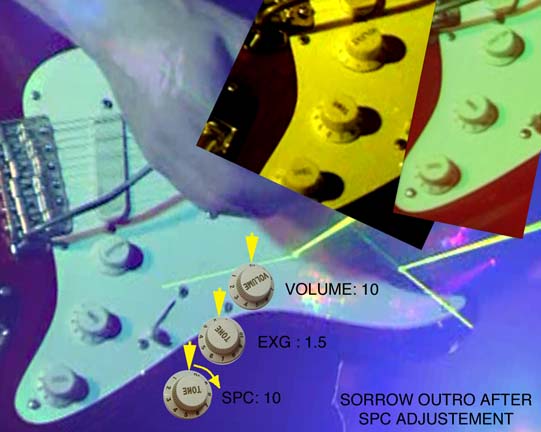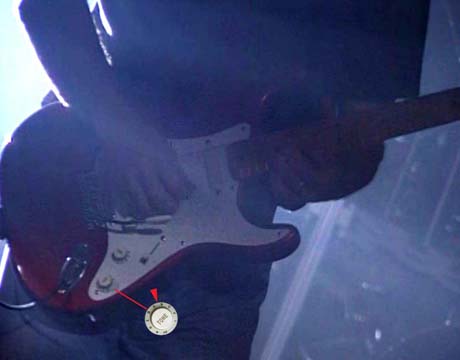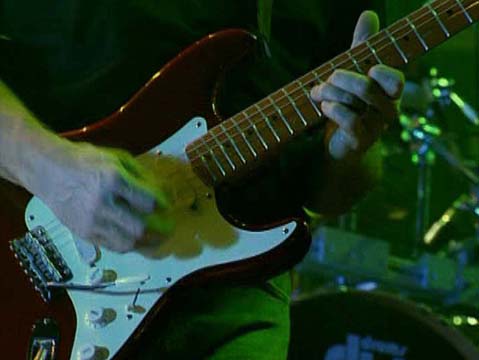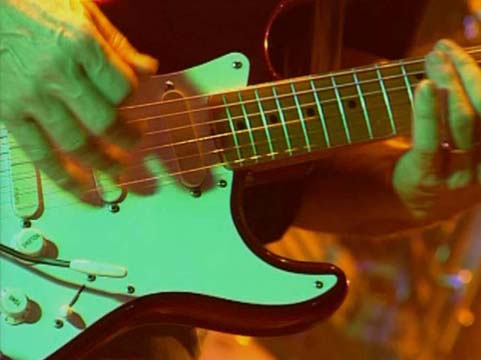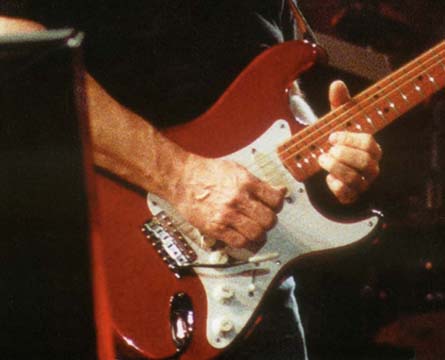NOTE: This website is frequently updated. Last update March 2022
EMG-DG20 ACTIVE PICKUPS - EMG SA noiseless active pickups are very much identified with David Gilmour of Pink Floyd, but they have actually been around since the late 1970s, with an updated design in 1979, long before David began using them. He switched from using passive single coil pickups in his Strats to EMG-SA pickups in 1985 to help reduce the RF noise and interference from the lighting rigs when he played live. EMGs were fitted in all of his 1983 and 1984 vintage series reissue Stratocasters that he used from 1985-1994. A candy apple red '57 reissue Stratocaster fitted with EMGs became his favorite stage guitar. It was used as his primary guitar for the 1994 Pink Floyd tour, as heard in Pulse, the live album and concert video of the tour. EMG-SA pickups are considered by many to be the heart of the Pulse tones, although Gilmour himself really only used them for their noise reduction qualities, not because he thought the pickups sounded better than standard Strat pickups.
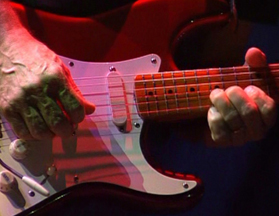
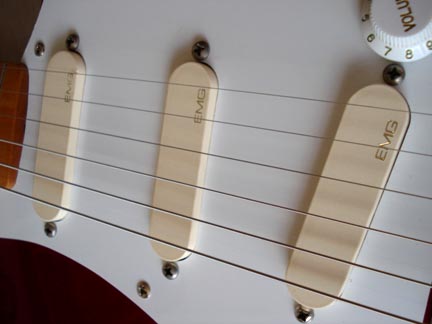
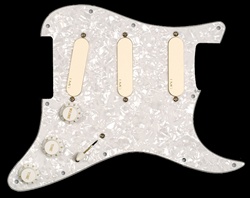
Gilmour's '57 reissue red strat with EMG-SA pickups and SPC/EXG controls and the Pro Series EMG DG20 pre assembled pearl pickguard woth the same pickups and controls
EMG-SA SPECIFICATIONS (from a 1990s EMG catalog)
Logo Color: Gold
Resonant Frequency (Khz) 3.75RMS
Output Voltage 0.6
Peak Output Voltage 0.85
Output Noise (dBV) -90
Output Impedance (Kohm) 10
Current @ 9V (Microamps) 80
Battery Life (Hours) 3000
The Pro Series DG20 set from EMG includes three of their SA pickups wired with an EXG guitar expander circuit and an SPC presence control circuit. These are "active" single coil pickups, which means they are powered internally by a 9V battery, rather than passive like vintage style pickups, which are powered by the low level line signal. Strangely, the DG20 set comes mounted on a pearloid pick guard, even though Gilmour never used that color. His Red Strat pick guards were always white.
For many years, one of the problems of touring was [radio-frequency] interference-- especially if you're the sort of bastard, like me, who tends to use a huge pedal board. Those effect pedals really tended to pick up interference, as did the dimmers on the lighting rigs. And with Pink Floyd, we did have extensive lighting rigs, which buzzed horribly. But when I first heard of and got hold of those EMG pickups, they stopped that dead. They sounded great, with a very full and rich tone, but they didn't sound quite as "Stratty" in some ways. There's something about a Strat's thin sound and tonal range that makes it a Strat. With EMG pickups, you tend to lose that a little bit. - David Gilmour from Guitarist 2006
The "SA" in the name means Single coil pickups with Alnico magnets. The single coil Alnico pickups themselves are really not much different than vintage style single coils with Alnico magnets, but EMGs include extra circuitry. The pickups are integrated with a built in signal-boosting preamp plus a buffered line driver, all in one. Because it has an active preamp, lowering the guitar volume just reduces the preamp's output and does not change the tone as it does when lowering the volume in a standard Stratocaster with passive pickups. The active circuit also means there is no need for the pickups to be grounded like a passive pickups. The lack of a ground and the low impedance of the pickups reduces the RF interference noise common with passive pickups. In other words, they are practically silent. Active pickups also minimize signal loss while driving the signal through long cable runs to the amp.
EMG DG-20 set from a 1990s EMG catalog
SPC Control - In place of the tone knobs David had EMG's SPC and EXG controls installed in his EMG Strats. David did not really use the EXG control, at least that we know of, so it was usually dialed off. He did use the SPC (Strat Prescence Control) control often. That is the one that us Gilmour tone freaks rave about, and many consider the EMG + SPC a holy grail for Pink Floyd's Pulse era guitar tones because of the unique sound.
The SPC is a presence control that boosts the mids, or rather the low mids. It does sort of what a humbucker does. It sharpens the tone while keeping the "thickness" intact and smooth, but boosts certain mid range frequencies so the guitar really stands out in a mix. It is perfect for use with Tube Driver and Big Muff pedals, which have a scooped mid range and tend to get lost in a mix. Mechanically the SPC is very similar to the old Craig Anderton Frequency Booster circuit and the Eric Clapton Mid Boost circuit. The Clapton mid boost control at its lowest setting is basically the same amount of mid boost as the SPC control on maximum. Gilmour actually briefly owned a Clapton Strat with the mid boost, but it was not to his taste. The fact that you cannot reduce the Clapton boost lower or turn it off was probably unworkable for how David used it.
EMG-DG20 SA ACTIVE PICKUPS VS. STANDARD PASSIVE SINGLE COIL PICKUPS - In this section I compare the David Gilmour EMG-DG20 pickup set (EMG-SA) to vintage style Fender Custom Shop '69 neck pickup and Seymour Duncan SSL-5 bridge pickup. David used EMGs throughout the 1980s and 1990s, but as the shielding and lighting rigs improved over the years, the noise issues also improved. In 2005 David returned to using his famous old Black Strat with passive single coil pickups and it became his primary Strat once again. It was fitted with a Seymour Duncan SSL-5 bridge pickup and a Fender Custom Shop '69 neck pickup.
Since I am comparing the EMG pickups to those, I'll start with a few words about them. The SSL-5 has more winds than a typical single coil pickup, something not exactly considered 'vintage'. Typically these overwound pickups are called "hot" pickups because they have a higher signal output than standard wound single coils. The higher output brings out more sensitivity in playing, pinch harmonics, et cetera, but they also have a more compressed sound than standard pickups because of the higher output. They are perfect for the bridge position in a Strat. Lower output pickups are fine in that position, but they may not sound as dynamic as higher output pickups when using distortions, especially high gain distortion like the Big Muff. The CS '69 is a lower output, vintage style pickup. It has fatter lows and nice and bright highs, which are perfect for the more bluesier clean and lightly overdriven tones of the Strat neck position.
EMG SAs are very much identified as Gilmour pickups because of the SPC tone circuit included with the DG20 set, but do they really sound that different than single coils? You be the judge. The following sound clips both use the exact same effects and amp setup. Only the pickups on the Strats were changed.
![]() Sorrow Solo and pinch harmonics – SSL-5 bridge pickup. Sovtek Civil War Big Muff > Tube Driver > TC Delay > Boss CE-2 Chorus > Reeves Custom 50
Sorrow Solo and pinch harmonics – SSL-5 bridge pickup. Sovtek Civil War Big Muff > Tube Driver > TC Delay > Boss CE-2 Chorus > Reeves Custom 50
![]() Sorrow Solo and pinch harmonics – EMG SA bridge pickup, SPC control on full. Sovtek Civil War Big Muff > Tube Driver > TC Delay > Boss CE-2 Chorus > Reeves Custom 50
Sorrow Solo and pinch harmonics – EMG SA bridge pickup, SPC control on full. Sovtek Civil War Big Muff > Tube Driver > TC Delay > Boss CE-2 Chorus > Reeves Custom 50
![]() Sorrow Intro – SSL-5 bridge pickup. Cornish P-2 > Boss MZ-2 > Tube Driver > TC Delay > Boss CE-2 Chorus > Reeves Custom 50
Sorrow Intro – SSL-5 bridge pickup. Cornish P-2 > Boss MZ-2 > Tube Driver > TC Delay > Boss CE-2 Chorus > Reeves Custom 50
![]() Sorrow Intro – EMG SA bridge pickup, SPC control on full. Cornish P-2 > Boss MZ-2 > Tube Driver > TC Delay > Boss CE-2 Chorus > Reeves Custom 50
Sorrow Intro – EMG SA bridge pickup, SPC control on full. Cornish P-2 > Boss MZ-2 > Tube Driver > TC Delay > Boss CE-2 Chorus > Reeves Custom 50
![]() Shine on You Crazy Diamond intro clean intro – Fender CS69 neck pickup. Boss CS-2 Compressor > Boss CE-2 Chorus > TC Delay > Reeves Custom 50
Shine on You Crazy Diamond intro clean intro – Fender CS69 neck pickup. Boss CS-2 Compressor > Boss CE-2 Chorus > TC Delay > Reeves Custom 50
![]() Shine on You Crazy Diamond intro clean intro – EMG SA neck pickup. Boss CS-2 Compressor > Boss CE-2 Chorus > TC Delay > Reeves Custom 50
Shine on You Crazy Diamond intro clean intro – EMG SA neck pickup. Boss CS-2 Compressor > Boss CE-2 Chorus > TC Delay > Reeves Custom 50
As you can hear from these clips, there is very little difference in the sound between the regular passive single coil pickups and the active EMG pickups with the SPC off. The EMGs sound practically the same using clean tones, and when using distortion, cranking the SPC control up allows the EMG to sound nearly the same as a high output passive pickup. That does not mean there is no difference. There is a slight mid range boost with the EMGs and they have a much wider range of possible tones than a regular Strat. Plus they are practically noiseless compared to passive pickups, and have less signal loss with long guitar cables.
Shown above - Gilmour playing the Red Strat in 1985 (left), the Red Strat and backup Red Strat from 1994 (middle), and the Red Strat from 2016 (right)
GILMOUR'S RED V57 REISSUE RED STRAT - In 1984 David went to the Fender warehouse and picked out several new Strats from their vintage reissue series (reportedly 5 or 6). All were later modified to have the tremolo arms shortened so David could hold them in his palm while playing, and EMG-SA noiseless pickups with SPC/EXG controls installed. One of those was a candy apple red (CAR) '57 reissue Strat. Its first major appearance being used on stage by Gilmour was the Live 8 benefit concert in 1985 with Bryan Ferry's band. The Red Strat would go on to become one of his favorite guitars to perform with live from 1986-1990, and his main guitar for the 1994 Pink Floyd world tour. In the studio he used it on Signs of Life and Learning to Fly from Pink Floyd's Momentary Lapse of Reason and The Division Bell album , and for his 2006 solo album On An Island.
David needed a spare guitar for the 1994 Pink Floyd tour and his backline tech, Phil Taylor, ended up finding a nearly identical one. Mick Ralphs of Bad Company was the backup guitarist for David Gilmour's 1984 touring band. When they were performing in New York in May 1984, David and Mick both went to Mannys music store to look at guitars. Mick found a candy apple red Strat he liked, almost the same as David's red '57 reissue. Mick bought it, but David wished he had seen it first. Years later in 1993 Phil Taylor was in Chandler's (Chandler Guitars in the U.K.) looking at guitars for Gilmour. He spotted a similar red Strat for sale, which turned out to be the same one owned by Mick, so he bought it as a backup for the 1994 tour.
Shown above (L to R) - pickup cavities in a Fender American Vintage Reissue 57 Strat before and after routing to allow the EMG pickup height to be set very low
David had his red '57 reissue EMG Strat modified to get it as close to the sound of his regular passive single coil Strats as possible. This primarily involved routing the pickup cavities deeper to allow the EMG pickup heights to be reduced farther into the pickup cavity, allowing the pickup height to be set lower than what was possible in the stock 57 reissue Fender body. Presumably his spare red EMG Strat was also given the same modification. Fryer Guitars did this and a few other mods to the Red Strat in early 1988 when Pink Floyd was on tour in Australia. The depth of the reissue cavities was 5/8", but David had them routed 3-4mm deeper. Each of David's pickups appears to be set less than 3mm (1/8") above the pickguard. Considering the vintage white pickguard on David's red Strat is only a 1-ply 0.060" thickness, they are set very low indeed. David's string gauge at this time was .010, .012, .016, .028, .038, .048.
Phil (Phil Taylor, David's gear tech) told me that David particularly liked to set the EMG pickups as low as possible in the pickguard which gave him a more Strat-like tone from the powerful output fatter sounding EMG pickups. In other words, setting them low ‘thinned up’ the EMG sound somewhat and gave more of an approximation to the original style Strat pickup sound that David favoured - Greg Freyer / Freyer Guitars
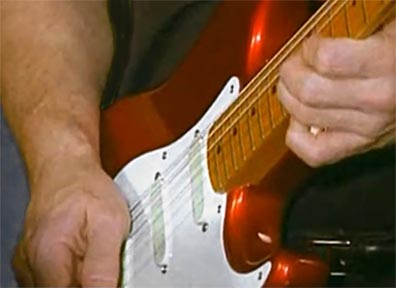
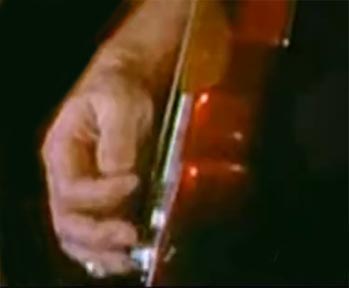
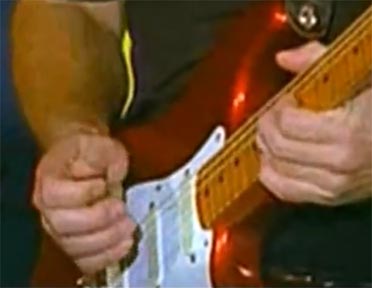
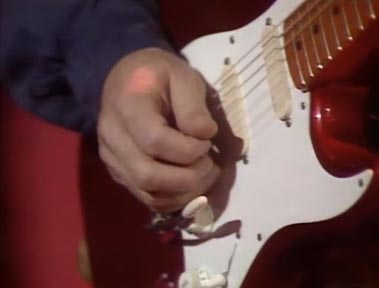
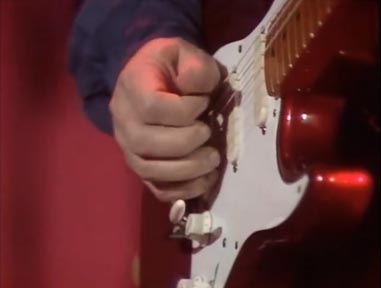
Shown above - Note the thin 1-ply pick guard and how low Gilmour's EMG pickup are set. The pickup cavities were routed deeper so his EMG pickup heights could be set lower than what was possible in the stock 57 reissue Stratocaster.
Shown above - David had a blue triangle added over the #8 on the volume knob, presumabley to make it easier to see on stage. David almost always had the volume set on 10 for solos, so this may have been his rhythm setting.
GILMOUR'S FLOATING BRIDGE SETUP - There is a lot of misinformation about whether or not Gilmour had a floating bridge or a fixed bridge on his Strats. I think his bridge plates were flat on the body in his early days with Pink Floyd, but around 1976 he started using floating bridges. You can hear and see David pitch notes up when pulling up on the whammy bar when playing live, which cannot be done with a non-floating bridge. The fact that the bridge is floating about 1.5mm off the body can also be seen in photos. The screw side of the bridge plate contacts the body and the saddle side floats. David tightens the two outer screws down so the bridge lightly contacts the body, but not too much. The four inner screws are raised so they do not press down on the bridge plate.
Shown above - David's floating bridge is set with the two outer screws tightened down so the bridge plate lightly touches the body and the back end is raised about 1.5mm off the body.
GILMOUR'S PICKUP HEIGHTS - Gilmour seated his EMG pickups low in the pickup cavities to make them sound more Strat-like. I do not have measurements for the heights but below are photos of the pickups in Gilmour's Red Strat for reference. Keep in mind that this pick guard thickness is only 1-ply, which is approximately 1.4mm/.055" thick, so visually the pickups appear to be seated higher than they would appear on a thicker 2 or 3-ply pick guard. Also note the high E string side of each pickup is slightly higher than the low E side. Note the wear on the high E side of the middle pickup, which is where David often stuck the middle pickup with his pick.
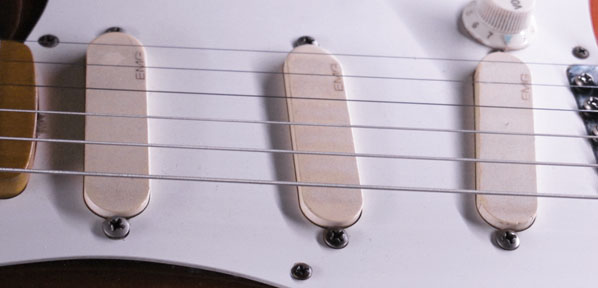
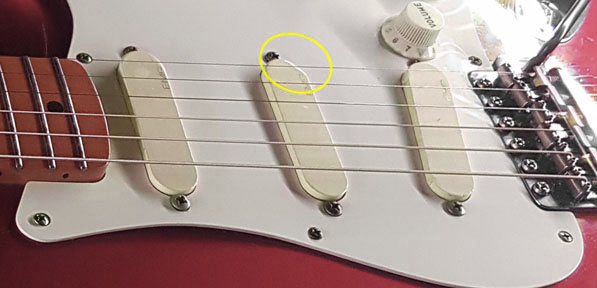
Shown above - Gilmour's EMG-SA pickups from 2018. Note the extreme wear on the middle pickup (circled),
indicating where David picked the most and that he was very hard on the picks and strings.
If you want more info on the Red Strat, a good article can be found on the Gilmourish.com website, HERE.
EMG-DG20 CONTROLS, SOUND and SETUP - The first thing I must point out is that the SPC and EXG knobs are in reverse position in some DG-20 sets, so you should determine which is which on your set. I have a newer set with solderless plugs that has the SPC in the middle and EXG farthest from the volume knob. I also have an older set that has those reversed, like the arrangement in Gilmour's red Strats.
EMG SA pickups take some getting used to, so give them some time. It took me a long time to warm up to them and learn their strengths. They sound excellent for clean tones using the neck position, although I think vintage style passive pickups like the CS' 69 sound just as good. For Delicate Sound of Thunder/ Pulse era Pink Floyd tones, especially with a Tube Driver or Boss CS-2 compressor, the SA neck pickup definitely hits the mark. The SA pickup in the bridge position produces very distinct warm mids and a bright tone when using fuzz-distortions like the Big Muff, Cornish P-1 or P-2, Butler Tube Driver, or Boss distortions like the HM-2 and MZ-2. EMGs really help get that Boss HM-2/Mesa Boogie Mark III tone from the Delicate Sound of Thunder and the Tube Driver into a Big Muff tone from the Pulse era, but passive single coils sound better to me for 1970s Fuzz Face and Colorsound Power Boost tones. The SA's are great when you want that P90 humbucker type tone from a Strat and excellent for clean and overdrive tones as heard in the live versions of Shine On You Crazy Diamond from Delicate Sound of Thunder and Pulse.
As stated earlier, the SPC (Strat Prescence Control) is a presence control that boosts the lower mids. The EXG (Expanded Guitar) cuts the mids and boosts the bass and treble, or scoops the tone. Turn both knobs to 1 and they are disabled and you only hear the straight pickup tone, which is very good by itself without any EXG and SPC EQ'ing. In the bridge position it does not sound exactly like a vintage style single coil pickup, or a hotter pickup like the SSL-5. The EMG pick attack has a somewhat compressed feel to it compared to passive pickups, and the bloom that occurs with sustained notes does not have the same vintage character. The EMG pickup height can be set much lower than passive pickups to compensate for these differences, but the change is minimal.
I don't care much for the EXG control for any Gilmour tones so I usually keep it at 0. I use it to thicken up my clean tones for non-Gilmour sounds, but anything higher than 5 does not sound good in my rig. Based on concert videos Gilmour does not use it much either, if at all. I like keeping the SPC control off for clean tones, but for distortion I raise it between 5 and 10. The boosted output and mids make my vintage Big Muffs sound very articulate. It is also easy to get very distinct harmonics and feedback with the SPC cranked up. I usually have the guitar volume set from 7-10.
Three sets of EMG SA pickups, each with a slightly different circuit layout and solderless plugs. Note that the SPC and EXG knobs are in reverse position on some DG20 sets
EMG suggests to set the pickup heights close to the strings for best results, but I suggest you adjust them by ear. Set them very high and play clean, then set them very low and play clean. Then use whichever sounded better to you as a starting point and adjust each by ear. The high E/treble side of the pickups will most likely need to be set slightly higher than the bass side to get a balaced volume of all six strings, and the middle pickup will most likely need to be set lower than the other two to get a balanced sound in position 2 and 4 on a Strat. I did not like the sound of the pickups close to the strings at all and after tweaking I found that farther away worked better for me.
DISTORTION - Here are two clips of a distortion tone using EMG-DG20's, showing the difference with the SPC and EXG controls. Fender Deluxe strat with EMG-DG20 pickups -> Boss CS-2 compressor -> BK Butler Tube Driver -> Big Muff -> Boss GE-7 Equalizer set for mids boost ->TC Nova delay -> Boss CE-2 chorus -> Fender 65 Twin Reverb amp.
SPC CONTROL
![]() Demo of SPC control on and off with a Big Muff using bridge pickup.
Demo of SPC control on and off with a Big Muff using bridge pickup.
COMPARISON CLIPS - EMG SA Strat with SPC control compared to a Seymour Duncan SSL-5 vintage style passive bridge pickup for comparison.
![]() Demo of SPC control on 10 with a Big Muff using EMG SA bridge pickup
Demo of SPC control on 10 with a Big Muff using EMG SA bridge pickup
![]() Same as above but with SPC off
Same as above but with SPC off
![]() Seymour Duncan SSL-5 bridge pickup
Seymour Duncan SSL-5 bridge pickup
EXG CONTROL
![]() EXG control on 10. SPC on 0. Muff distortion on bridge pickup.
EXG control on 10. SPC on 0. Muff distortion on bridge pickup.
![]() EXG control on 2. SPC on 0.
Muff distortion on bridge pickup.
EXG control on 2. SPC on 0.
Muff distortion on bridge pickup.
Here is the same pedal board setup, but with a Seymour Duncan SSL-5 passive bridge pickup for comparison.
![]() Seymour Duncan SSL-5 bridge pickup. Muff distortion.
Seymour Duncan SSL-5 bridge pickup. Muff distortion.
CLEAN - Here are examples of a clean tone through the EMG pickups. Fender Deluxe strat with EMG-SA neck pickup -> Boss CS-2 compressor -> TC Nova delay -> Fender 65 Twin RI amp.
![]() EXG control on 10. SPC on 0. Clean neck pickup tone.
EXG control on 10. SPC on 0. Clean neck pickup tone.
![]() EXG control on 2. SPC on 0.
Clean neck pickup tone.
EXG control on 2. SPC on 0.
Clean neck pickup tone.
Here is the same setup, but with Fender Custom Shop '69 passive neck pickup for comparison.
![]() Fender Custom Shop '69 neck pickup.
Fender Custom Shop '69 neck pickup.
EXG SETTINGS - Here is some clean tone noodling with the EXG control in different positions, mostly with the neck pickup. I think the SA pickups are the best out there for clean bluesy Strat tones, and the EXG can fatten up the neck pickup sound nicely by scooping the tone. Fender Deluxe strat with EMG-SA neck pickup -> Boss CS-2 compressor -> TC Nova delay -> Fender 65 Twin RI amp.
![]() Clean tones with different EXG settings.
Clean tones with different EXG settings.
ON THE TURNING AWAY IMPROV - Here are the EMG-DG-20 pickups in all their glory, playing along to a backing track of Pink Floyd's On the Turning Away solo.
![]() Boss CS-2 Compressor > Red Army Overdrive (same as a Civil War Big Muff) > B.K. Butler Tube Driver > Boss GE-7 EQ > Boss CE-2 Chorus (70% in mix using a Barge VB Jr. loop mixer) > TC Electonic Nova Delay > cranked Fender TWin Reverb
Boss CS-2 Compressor > Red Army Overdrive (same as a Civil War Big Muff) > B.K. Butler Tube Driver > Boss GE-7 EQ > Boss CE-2 Chorus (70% in mix using a Barge VB Jr. loop mixer) > TC Electonic Nova Delay > cranked Fender TWin Reverb
DAVID GILMOUR'S RED STRAT EMG-DG 20 SETTINGS
These settings may not apply to your gear because your amplifier, effects, and your gear settings may sound different than David's 1994 Pink Floyd rig, but if you have a similar rig to David's they should work. I use David's volume knob setting as a basis for where 10 would be on his red strat, as there are several solos that I know the volume is set on 10. David also has a blue arrow indicator over the #8 on his volume knob. Since most of his solos are on 10, I assume this mark was added for his rhythm volume.
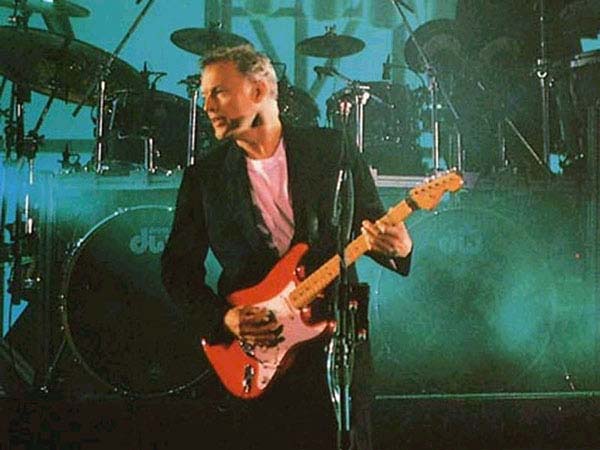
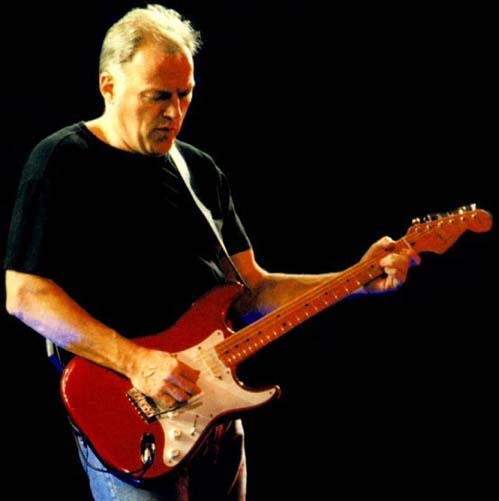

Based on the Pulse DVD and On An Island Gdansk concert it would appear David's EMG-DG 20 solo settings typically are:
Vol : Always on 10
EXG : Always on 1 to 1.5
SPC : Around 1 for clean solos, and around 5 for distortion.
Here are David's settings from the first Coming Back to Life solo on the Pulse DVD, pictured below. I use David's volume knob setting as a basis for where 10 would be on his red strat. During the show, and in the intro solo to this song in particular, you can see David check to see if his volume is all the way up. Based on that, and the fact that it is mostly seen in this same position during solos, I think his volume is always on 10 for solos.
Vol : 10
EXG : 1
SPC : 1
The second and third solos look to be the same, pictured below, but the SPC is now on 4.5 (based on the direction TONE reads and the gap between 10 and 0 on the SPC knob). Just before the second solo you can see David check the knob position on the SPC.
Vol : 10
EXG : 1
SPC : 4.5
For Shine On You Crazy Diamond it is harder to see the settings for the intro on the Pulse DVD, pictured below, but if you look close at the two camera angles on a big screen you can see the light glint off the knobs and reveal the tone position. The SPC is either on 1 or 6.5. I can't see which direction TONE reads to know for sure, but listening I think this is 1. For the vocal section of the song the EXG is set at 1. I assume it is always set at 1 since the position never seems to change in any song. Volume is 10.
David also used the EMG strat for this song during the On An Island tour. The settings can be seen at various in the Live in Gdansk performance, pictured below (thanks to Rafal Zychal for the pix).
Vol : 10
EXG : 1-2
SPC : 1-2
The Pulse DVD settings for Sorrow vary during the song. The intro is show below. Gilmour has the SPC around 10 for this song.
The fills and both guitar solos have the settings shown below.
The Sorrow outro solo settings from different points in the solo are shown below. After the first few notes David increases the SPC control from around 1 all the way to 10. This helps with the feedback needed for the intro.
Comfortably Numb first solo settings from the Pulse DVD are shown below.
Vol : 10
EXG : 1
SPC : 1
For the second CN solo, shown below, the EXG is 1, and the SPC is around 4.5.
Vol : 10
EXG : 1
SPC : 4.5 to 5 (position based on gap bewteen 1 and 10 on knob)
The photo above is from Phil Taylor's excellent book, The Black Strat. This photo appears to be from the Division Bell tour.
Kit’s Secret Guitar, Gear, and Music Page
Guitar stuff, gear stuff, soundclips, videos, Gilmour/Pink Floyd stuff, photos and other goodies.
Copyright Kit Rae.
VISIT MY SWORDS, KNIVES and FANTASY ART WEBSITE www.kitrae.net

